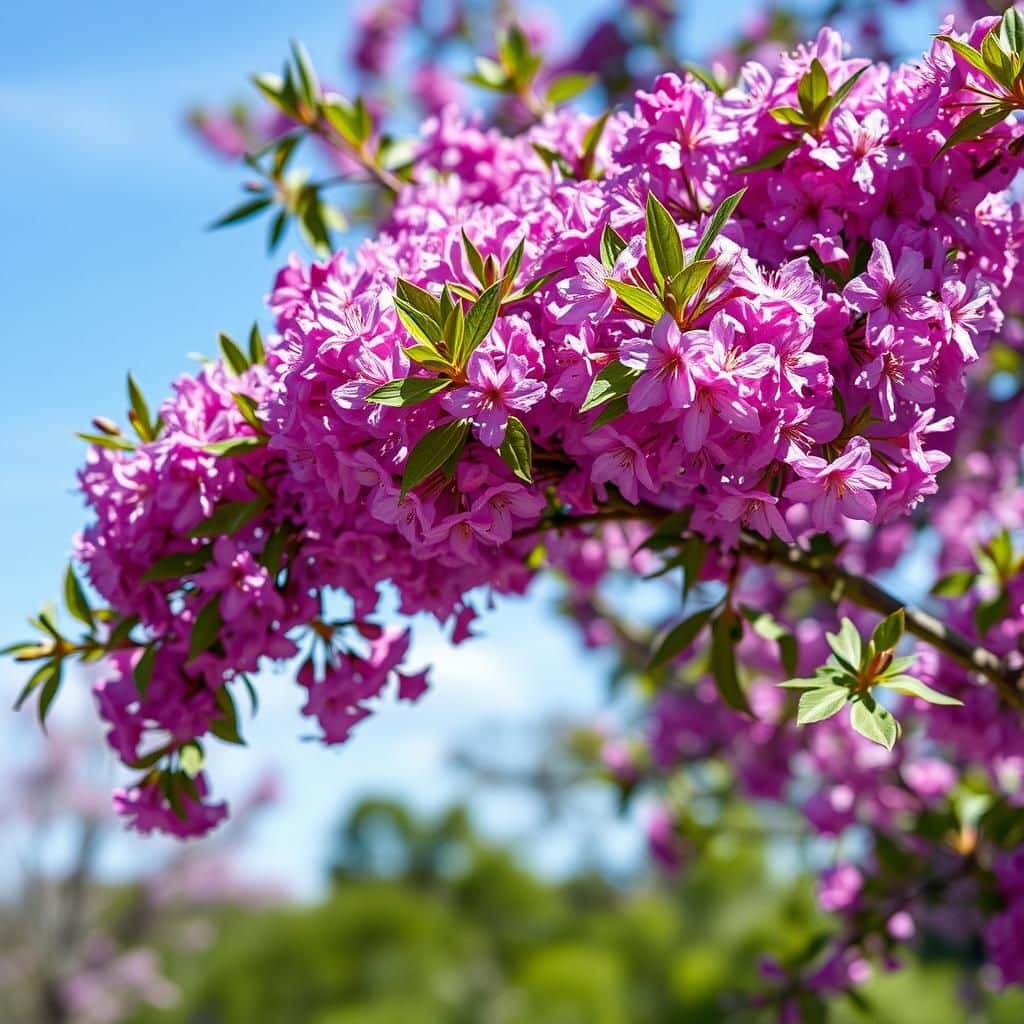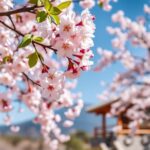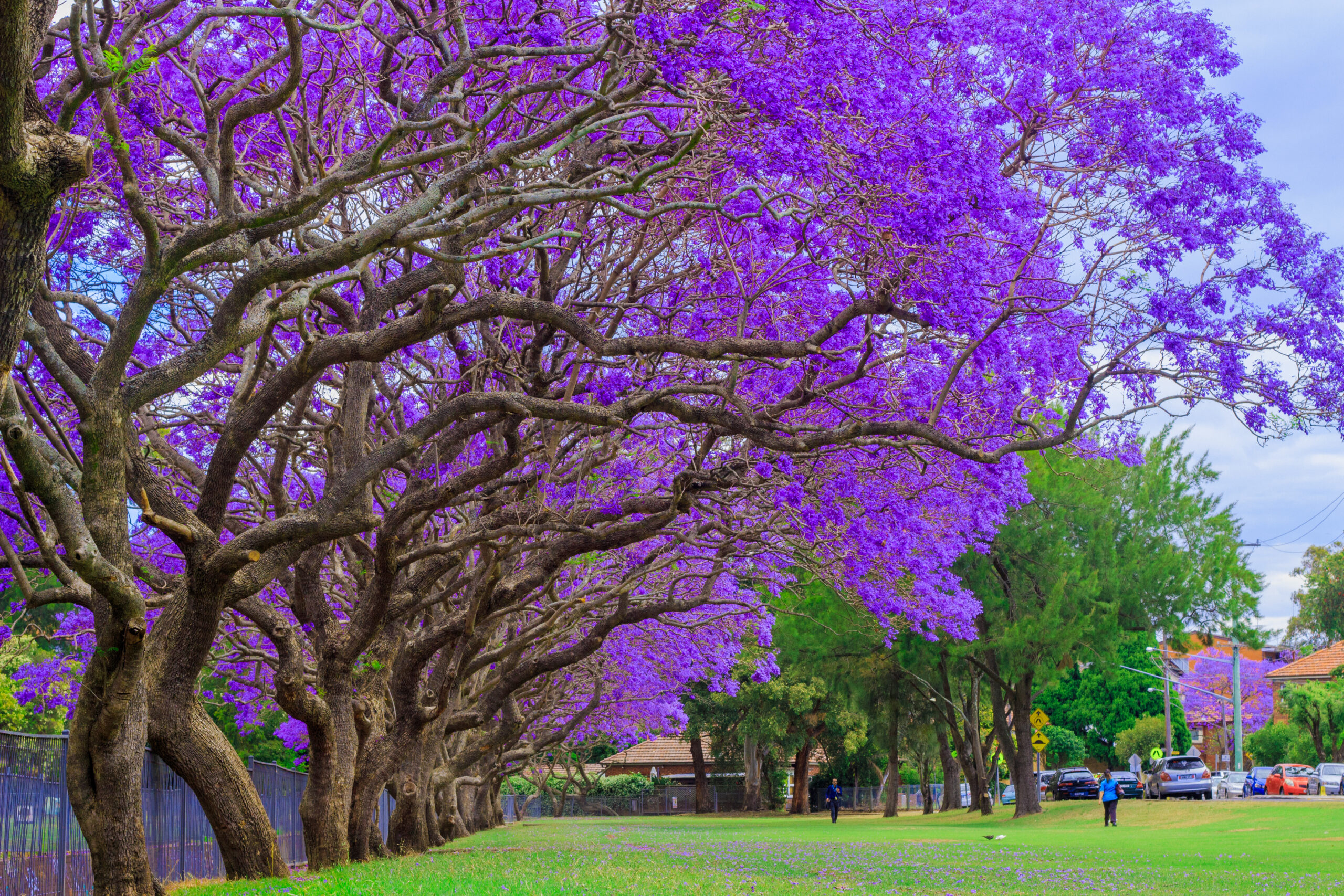Exploring the Beauty of the Purple Flowering Tree Australia: A Guide to Types and Care

Australia is home to a stunning variety of flora, and among its most enchanting sights is the purple flowering tree. These vibrant trees, with their striking blossoms, not only enhance the landscape but also provide a habitat for wildlife. From Jacarandas to Purple Trumpet Trees, the diversity is remarkable. This guide aims to explore the different types of purple flowering trees found in Australia, along with essential tips for their care and maintenance. Whether you are a gardening enthusiast or simply captivated by their beauty, understanding these trees will enrich your appreciation of Australia’s unique botanical treasures.
Purple Flowering Trees in Australia
Australia is home to a variety of stunning purple flowering trees that add vibrant color to its landscapes, particularly in the warmer months. Among the most notable species is the Jacaranda mimosifolia, widely recognized for its striking clusters of lavender-blue flowers that create a breathtaking spectacle when in full bloom. This tree thrives in various Australian climates, favoring sunny areas and well-drained soil, making it a popular choice for street plantings and parks. Its delicate, fern-like foliage complements the colorful blooms, and as an added benefit, the Jacaranda provides shade and habitat for local wildlife. The blooming season typically occurs from late spring to early summer, transforming landscapes into idyllic scenes that attract both locals and tourists alike.
Types of Purple Flowering Trees
There are several species of purple flowering trees found throughout Australia, with the Jacaranda being the most prominent. Other notable species include the Pride of India (Lagerstroemia indica), which showcases beautiful purple flowers and is widely used in urban landscaping. The Ceratonia siliqua, or carob tree, also bears purple flowers but is less common. Each of these trees offers unique characteristics, ranging from flower shape to overall size, and contributes to the richness of Australia's flora.
Ideal Growing Conditions
To thrive, purple flowering trees like the Jacaranda prefer full sun and a warm climate, making many regions of Australia perfect environments for their growth. These trees flourish in well-drained soils, often tolerating poor soil conditions, as long as there is adequate drainage. Regular watering is important during the establishment phase, but once adapted, they require minimal irrigation. It is also essential to protect these trees from strong winds, which can damage their delicate branches during flowering.
Maintenance and Care
Proper maintenance of purple flowering trees involves regular pruning, especially after the blooming season to encourage healthy growth and shape the tree. It’s important to remove any dead or diseased branches to prevent infestations and ensure the health of the tree. While these trees are relatively low-maintenance, occasional fertilization during the growing season can promote even more abundant flowering. Mulching around the base can help retain moisture and suppress weeds, allowing the tree to flourish.
Cultural Significance
The Jacaranda, in particular, holds a significant place in Australian culture. As it blooms, it often marks the end of the academic year for students in many cities, who associate the stunning purple flowers with festive celebrations. Jacaranda festivals, which celebrate the blooming of this tree, attract visitors eager to witness the spectacular views and participate in community gatherings. Additionally, the tree has inspired artists and poets, becoming a symbol of beauty and transience in Australian cultural expressions.
Pests and Diseases
Despite their resilience, purple flowering trees can be subject to various pests and diseases. Common pests that affect the Jacaranda include aphids and scale insects, which can reduce the tree’s vitality if not managed properly. Fungal diseases can also occur, particularly in overly moist conditions, leading to leaf spots or root rot. Regular monitoring and prompt intervention using organic pesticides or fungicides, when necessary, are crucial for maintaining the tree's health and ensuring vibrant blooms each season.
| Tree Species | Flower Color | Height | Blooming Season |
|---|---|---|---|
| Jacaranda mimosifolia | Lavender-Blue | 10-15 m | Spring to Summer |
| Lagerstroemia indica | Purple | 3-6 m | Summer |
| Ceratonia siliqua | Purple | 8-15 m | Late Spring |
Can Jacaranda trees grow in the US?
Yes, Jacaranda trees can grow in the United States, primarily in the warmer regions. Their native habitat is tropical and subtropical areas, which makes them well-suited for certain climates in the U.S. The Jacaranda mimosifolia, the most common species, thrives in areas with mild winters and sufficient rainfall during the growing season. Below are some details regarding the conditions necessary for their growth and the areas where Jacaranda trees are most commonly found in the U.S.
Suitable Climates for Jacaranda Trees
Jacaranda trees prefer warm climates with mild winters. They are not frost-resistant and can struggle to survive in areas where temperatures drop below freezing. The ideal growing conditions include:
- Temperatures: They thrive best in regions with average temperatures ranging from 65°F to 85°F.
- Watering Needs: Jacaranda trees need moderate watering during the summer months and require well-draining soil.
- Sunlight Exposure: They need full sunlight for most of the day to promote healthy growth and flowering.
Locations in the U.S. Where Jacaranda Trees Thrive
In the United States, Jacaranda trees typically grow in southern states, where the climate aligns with their growth requirements. Key areas include:
- California: Particularly in Southern California, Jacarandas are common in cities like Los Angeles and San Diego.
- Florida: The warm, tropical climate offers ideal conditions for Jacaranda growth, with trees often found in urban landscapes.
- Texas: Specifically in southern regions, such as the Rio Grande Valley, where the climate permits their thriving.
Growth Characteristics of Jacaranda Trees
Jacaranda trees are renowned for their stunning purple flowers that bloom in late spring and early summer. Their growth characteristics include:
- Height: They can grow to be between 15 to 50 feet tall, depending on the conditions and care.
- Spread: The trees can have a broad canopy, often spreading 25 to 40 feet wide, providing ample shade.
- Lifespan: Jacaranda trees can live for 50 years or more when properly cared for, thriving in the right conditions.
Planting and Care Tips for Jacaranda Trees
If you are considering planting a Jacaranda tree, proper preparation and care are essential for its growth. Here are some important tips:
See also:
- Soil Quality: Choose well-draining soil, as Jacarandas do not tolerate waterlogged conditions.
- Pruning: Regular pruning helps maintain the shape of the canopy and removes any dead or diseased branches.
- Fertilization: Using a balanced fertilizer during the growing season can encourage robust growth and enhance flowering.
Common Pests and Diseases Affecting Jacaranda Trees
While Jacaranda trees are relatively resilient, they can be susceptible to certain pests and diseases. Being aware of them can help you take preventative measures:
- Scale Insects: These pests can infest the leaves, leading to yellowing. Monitor the tree's foliage for signs of infestation.
- Fungal Issues: Overwatering can lead to root rot and other fungal diseases. Ensuring proper drainage is crucial.
- Aphids: Though not typically harmful, they can weaken the tree and lead to sticky honeydew on the leaves.
What is the name of a tree with purple flowers?

The name of a tree with purple flowers is the Jacaranda tree. Known for its stunning, vibrant purple blooms that appear in spring, the Jacaranda (Jacaranda mimosifolia) is native to tropical and subtropical regions of South America. This tree has become popular in many parts of the world, including the United States, Australia, and various countries in Africa and Asia. The Jacaranda is not only admired for its beautiful flowers but also for its broad, fern-like leaves and its ability to create shaded areas in gardens and streetscapes.
Growth and Habitat of Jacaranda Trees
Jacaranda trees thrive in warm, sunny climates and are typically planted in well-drained soils. They are often found in urban landscapes and botanical gardens. Their growth can be quite rapid under ideal conditions:
- Sunlight: Jacarandas require full sun to flourish.
- Soil Type: Well-drained, sandy or loamy soil is preferred.
- Watering: Regular watering during the dry season promotes healthy growth.
Flowering Season and Characteristics
The flowering season of Jacaranda trees typically occurs in late spring to early summer. The purple flowers are trumpet-shaped and often bloom en masse, creating a spectacular display:
- Color: Bright lilac to deep purple hues are common.
- Fragrance: The flowers have a light, pleasant scent.
- Pollinators: They attract bees and butterflies, which play a role in pollination.
Uses of Jacaranda Wood
The wood of the Jacaranda tree is also valued for its use in various applications, from furniture to decorative items. Its properties make it sought after:
- Durability: Jacaranda wood is known for being hard and durable.
- Appearance: The wood typically features an attractive grain and color variations.
- Applications: Commonly used in crafting musical instruments, cabinetry, and flooring.
Cultural Significance of Jacaranda Trees
In many cultures, Jacaranda trees hold symbolic meanings and are celebrated in local traditions. They often mark the arrival of spring:
- Festivals: Cities may hold festivals to celebrate the blooming of Jacarandas.
- Symbolism: They often symbolize renewal and beauty.
- Tourist Attractions: Landscapes featuring Jacarandas attract tourists for their scenic beauty.
Maintenance and Care for Jacaranda Trees
To ensure the health and longevity of Jacaranda trees, proper care is essential. Maintenance practices can include:
- Pruning: Regular pruning helps maintain shape and remove dead branches.
- Pest Control: Monitoring for common pests and diseases is important for tree health.
- Fertilization: Applying fertilizer can promote stronger growth and blooming.
What tree looks like a jacaranda in Australia?

The tree that closely resembles a jacaranda in Australia is the Mimosa or Silk Tree (Albizia julibrissin). While the jacaranda tree is renowned for its stunning purple flowers, the mimosa features fluffy pink blossoms that also attract attention. Both trees are deciduous and provide a striking visual display, often complementing the landscapes where they are planted.
Botanical Characteristics
The Mimosa has unique botanical characteristics that set it apart from other trees. It features:
- Compound Leaves: The leaves are made of numerous small leaflets that give them a delicate appearance.
- Fluffy Flowers: The flowers are pink and tufted, resembling pom-poms, which are distinct yet somewhat similar to the jacaranda's intense blooms.
- Growth Habit: Like the jacaranda, the mimosa can grow into a large, spreading tree, often providing ample shade.
Geographical Distribution
The mimosa is primarily found in Asia but has become quite popular in Australia as well, often planted in gardens and streetscapes. Its distribution is marked by:
- Native Regions: Originally from Iran to Japan and the Eastern United States.
- Adaptability: Thrives in a variety of soils but prefers well-drained locations and full sun, making it a favorite in Australia's diverse climates.
- Urban Uses: Frequently used in urban landscaping, where its aesthetic appeal can mimic the jacaranda's beauty.
Care and Maintenance
To maintain a healthy mimosa tree, certain care practices are essential. These include:
See also:
- Watering: Regular watering is necessary during establishment; however, once established, it is quite drought-tolerant.
- Pruning: Pruning should be done to shape the tree and remove any dead or diseased branches, promoting healthier growth.
- Pest Management: Watch for common pests like aphids that may affect its health, and apply appropriate control measures when needed.
Comparison with Jacaranda
Comparing the mimosa to the jacaranda highlights both similarities and differences:
- Flower Color: While the jacaranda displays purple flowers, the mimosa showcases vibrant pink blooms.
- Leaf Structure: The jacaranda has broad leaves, whereas the mimosa features delicate, feathery foliage.
- Growth Rate: Both trees grow relatively quickly, but the mimosa can sometimes outpace the jacaranda in certain conditions.
Landscape Uses
In landscaping, the mimosa serves multiple aesthetic and functional purposes:
- Aesthetic Appeal: Its enchanting pink flowers provide a different yet attractive visual similar to jacarandas.
- Shade Provider: Its broad canopy offers significant shade, making it beneficial in parks and gardens.
- Pollinator Attraction: The flowers of the mimosa draw in numerous pollinators, contributing to biodiversity within garden settings.
What is special about the jacaranda tree?

The jacaranda tree (Jacaranda mimosifolia) is renowned for its striking beauty and ecological value. This tree is native to tropical and subtropical regions of South America, particularly in Argentina and Brazil, but it has been successfully introduced to many other parts of the world. Its most notable feature is its vibrant purple flowers that bloom in clusters, creating a stunning visual display, especially when in full bloom. The jacaranda tree not only adds aesthetic appeal to landscapes but also plays a role in local ecosystems.
Origins and Habitat
The jacaranda tree has its origins in the subtropical and tropical areas of South America. It thrives in well-drained soil and prefers warm climates. Here are some key points regarding its habitat:
- Native Regions: Originally found in countries like Brazil, Argentina, and Uruguay.
- Growth Conditions: Prefers sunny environments and can tolerate some drought.
- Adaptability: Successfully planted in diverse regions, including parts of Africa, Australia, and California.
Blooming Period
The blooming period of the jacaranda tree is one of its most anticipated features. During this season, the tree transforms landscapes with its purple blossoms. Key points include:
- Flowering Time: Generally blooms in late spring to early summer, depending on the climate.
- Visual Impact: Creates vibrant displays that often lead to purple rain when the petals fall, covering the ground.
- Pollination: Attracts various pollinators, particularly bees, which are essential for its reproduction.
Cultural Significance
The jacaranda tree holds significant cultural importance in several countries. Its beauty often symbolizes renewal and the passing of seasons. Key cultural aspects include:
- Symbolism: In some cultures, the blooming of jacarandas signifies new beginnings and creativity.
- Festival Celebrations: Various towns celebrate festivals dedicated to the flowering of jacarandas, showcasing local traditions.
- Art and Literature: Frequently depicted in art, poetry, and photography, representing beauty and elegance.
Ecological Benefits
Beyond its beauty, the jacaranda tree provides significant ecological contributions. Its role in the environment can be summarized as follows:
- Biodiversity: Offers habitat and food for a variety of wildlife, including birds and insects.
- Shade Provision: Provides shade in urban areas, helping to cool environments and improve air quality.
- Soil Improvement: The fallen leaves enrich the soil, promoting healthier ecosystems.
Uses in Landscaping
The jacaranda tree is a popular choice in landscaping thanks to its striking appearance and relatively low maintenance. Here are some common uses:
- Landscape Design: Used in parks, gardens, and streetscapes to enhance visual appeal.
- Street Planting: Often planted along roads and boulevards to create scenic views during blooming seasons.
- Shade Trees: Ideal for residential properties, providing shade and aesthetic value.
Questions from Our Readers
What are the common types of purple flowering trees in Australia?
Many purple flowering trees can be found in Australia, with the Jacaranda and Wisteria being among the most popular. The Jacaranda is renowned for its vibrant blue-purple blossoms, creating stunning displays during spring, while Wisteria showcases cascading clusters of purple flowers, adding beauty to gardens and landscapes.
When do purple flowering trees bloom in Australia?
In Australia, purple flowering trees typically bloom in spring, with the Jacaranda usually flowering from October to November. This period marks the peak of their beauty, transforming parks and streetscapes with a spectacular display of vivid purple hues that attract both locals and tourists.
How can I care for purple flowering trees in my garden?
To care for purple flowering trees, ensure they are planted in well-drained soil and receive full sunlight for optimal growth. Regular watering is important, especially during dry seasons, and fertilization can enhance flower production. Pruning after flowering is also recommended to maintain their shape and promote healthy growth.
Are purple flowering trees suitable for all climates in Australia?
While many purple flowering trees thrive in the subtropical and temperate climates of Australia, they may not be suitable for colder regions. Choosing the right species for your specific climate is essential, with Jacarandas being more tolerant of heat, while some species may require protection from frost during winter months.
See also:

If you want to read more articles like Exploring the Beauty of the Purple Flowering Tree Australia: A Guide to Types and Care, we recommend you check out our Landscaping category.
Leave a Reply

Related Articles